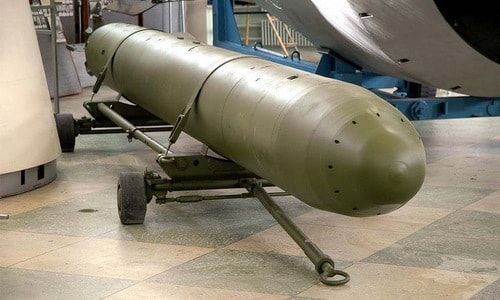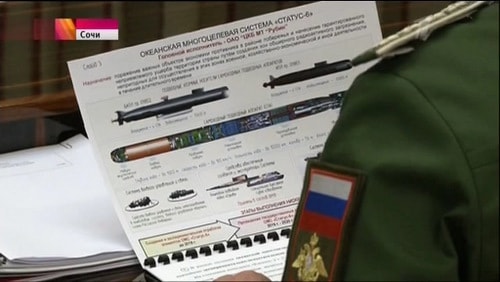Analysis of Russia's nuclear torpedo power
Russia manufactures nuclear-tipped torpedoes launched from submarines capable of destroying enemy aircraft carrier battle groups.
 |
T-5 torpedo prototype in a Russian museum. Photo: Survincicity. |
On October 10, 1957, the Soviet submarine S-144 launched a nuclear-tipped torpedo at a simulated target off the coast of Novaya Zemlya. The warhead had a yield of 10 kilotons, equivalent to 10,000 tons of TNT, detonating at a depth of 35 meters below the sea surface, completely destroying two destroyers, two submarines and two minesweepers, according to Sputnik.
The Soviet Union began research on nuclear torpedoes shortly after successfully testing its first nuclear bomb in 1949. The military believed that long-range bombers and ballistic missiles were key components of its nuclear deterrent, but aircraft were vulnerable to enemy air defenses, while ballistic missiles were still a technology in development.
"Submarines are a completely different matter. They demonstrated their power during World War II by secretly approaching enemy shores and then launching devastating attacks on enemy ports and infrastructure," said military expert Andrei Stanavov. The Soviet Navy also had many experienced submarine commanders, who pushed the country's military to develop nuclear torpedoes.
T-15 and T-5 torpedoes
The Soviet Union's first nuclear torpedo project, the "T-15", was launched in 1951. The T-15 was intended to be equipped on Project 627 "Kit" submarines, the first Soviet nuclear attack submarine class. Each T-15 was 1,550 mm in diameter, 20 m long, weighed 40 tons and had a range of about 40 km, and could be used to attack US naval bases and coastal cities.
The development of the T-15 was carried out in complete secrecy, to the point that the Soviet Navy was not even aware of the project’s existence. In addition to the giant T-15, a conventional 533 mm version of the T-5 torpedo was also proposed. Moscow saw the benefits of both torpedoes, the T-5 being far more practical and tactically effective, while the T-15 had many times greater destructive power.
By 1953, the Soviet Navy was surprised to receive the blueprints for the Project 627 submarine and the T-15 torpedo. However, they were less enthusiastic about the T-15 version, claiming that it took up 22% of the submarine's internal space, leaving each Project 627 to carry only one. Naval commanders also questioned the range and speed of the T-15 torpedo.
T-5 torpedo test in 1955
A panel of naval experts recommended terminating the T-15 project and instead focusing on perfecting the smaller T-5 variant. Each T-5 was equipped with an RDS-9 nuclear warhead, whose compact size made it easy to deploy on existing Soviet submarines.
The T-5 was first successfully tested with a 3 kiloton warhead in September 1955 off the Novaya Zemlya peninsula. The torpedo was not launched from a submarine. Instead, a minesweeper dropped the torpedo to a depth of 12 meters, before moving to a safe distance and detonating the warhead.
The Soviet Navy adopted the T-5 torpedo in 1958, a year after a successful test launch off Novaya Zemlya. It remained the Soviet Union's only nuclear torpedo until 1960.
During the 1960s and 1970s, the Soviet Union achieved nuclear parity with the United States. Nuclear-tipped torpedoes were phased out of service, in favor of intercontinental ballistic missiles (ICBMs) and submarine-launched ballistic missiles (SLBMs), as well as bombers carrying long-range cruise missiles.
In 1961, nuclear physicist Andrei Sakharov proposed the idea of building a thermonuclear warhead with a yield of 100 megatons, equivalent to 100 million tons of TNT, for submarine-launched torpedoes, after the Soviet Union successfully tested the Tsar Bomba.
Sakharov's concept of a submarine-launched, sea-skimming torpedo bore many similarities to today's 91RE1 missile of the Kalibr complex, but it never became a reality in the 1960s.
However, nuclear torpedoes suddenly reappeared in late 2015, when Russian television accidentally leaked the design drawings of the Status-6 torpedo while reporting on a meeting attended by Russian Defense Minister Sergei Shoigu. Similar to Sakharov’s proposal in 1961, Status-6 is said to carry a 100-megaton warhead, enough to create a 500-meter-high tsunami along the enemy’s coast.
 |
Status-6 torpedo drawings revealed on Russian television. Photo: Livejournal. |
Based on the design image, French experts believe that Status-6 is a torpedo equipped with an "automatic propulsion device", with a maximum speed of 185 km/h, an operating depth of 1,000 m and a range of 10,000 km, equipped with systems to neutralize the enemy's anti-submarine defense network. Status-6 is expected to be equipped on Project 949A or Project 09851 submarines.
The Status-6 torpedo can be fitted with a warhead with a superalloy casing containing cobalt-59, which can decay into radioactive material.cobalt-60afterexplosive reaction, causing long-term radioactive contamination around the target area. The US Department of Defense confirmed that Status-6 is a real project and was tested in late 2016.
According to VNE
| RELATED NEWS |
|---|


.jpg)





